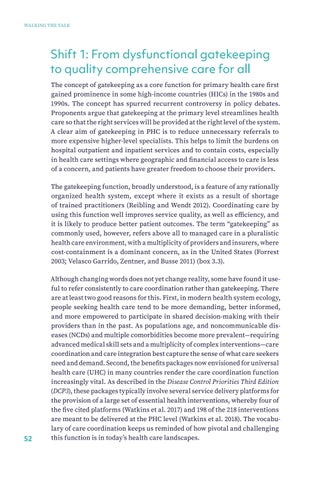WALKING THE TALK
Shift 1: From dysfunctional gatekeeping to quality comprehensive care for all The concept of gatekeeping as a core function for primary health care first gained prominence in some high-income countries (HICs) in the 1980s and 1990s. The concept has spurred recurrent controversy in policy debates. Proponents argue that gatekeeping at the primary level streamlines health care so that the right services will be provided at the right level of the system. A clear aim of gatekeeping in PHC is to reduce unnecessary referrals to more expensive higher-level specialists. This helps to limit the burdens on hospital outpatient and inpatient services and to contain costs, especially in health care settings where geographic and financial access to care is less of a concern, and patients have greater freedom to choose their providers. The gatekeeping function, broadly understood, is a feature of any rationally organized health system, except where it exists as a result of shortage of trained practitioners (Reibling and Wendt 2012). Coordinating care by using this function well improves service quality, as well as efficiency, and it is likely to produce better patient outcomes. The term “gatekeeping” as commonly used, however, refers above all to managed care in a pluralistic health care environment, with a multiplicity of providers and insurers, where cost-containment is a dominant concern, as in the United States (Forrest 2003; Velasco Garrido, Zentner, and Busse 2011) (box 3.3).
52
Although changing words does not yet change reality, some have found it useful to refer consistently to care coordination rather than gatekeeping. There are at least two good reasons for this. First, in modern health system ecology, people seeking health care tend to be more demanding, better informed, and more empowered to participate in shared decision-making with their providers than in the past. As populations age, and noncommunicable diseases (NCDs) and multiple comorbidities become more prevalent—requiring advanced medical skill sets and a multiplicity of complex interventions—care coordination and care integration best capture the sense of what care seekers need and demand. Second, the benefits packages now envisioned for universal health care (UHC) in many countries render the care coordination function increasingly vital. As described in the Disease Control Priorities Third Edition (DCP3), these packages typically involve several service delivery platforms for the provision of a large set of essential health interventions, whereby four of the five cited platforms (Watkins et al. 2017) and 198 of the 218 interventions are meant to be delivered at the PHC level (Watkins et al. 2018). The vocabulary of care coordination keeps us reminded of how pivotal and challenging this function is in today’s health care landscapes.


